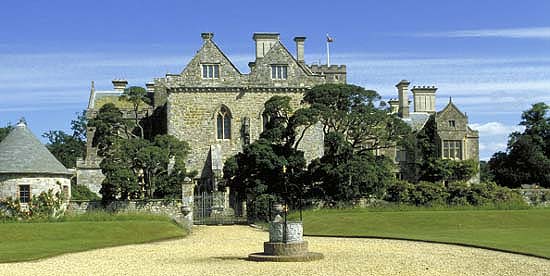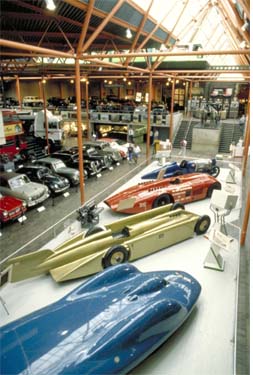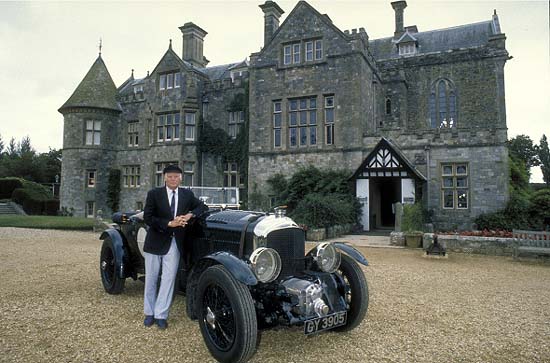Beaulieu and the National Motor Museum
by Barbara Johnson
Forests can be uncannily beautiful places and England's New Forest is no exception. A little over two hour's drive south from London and a few miles before reaching the coast, it's one of the oldest woodland areas in the country. For over 900 years the forest has been treasured and was formerly the hunting ground of kings. Hardly surprising then, that like all good forests, it's full of unexpected things.
Nomadic cattle and ambling donkeys appear along the way. Everything about the place, the narrow twisting, turning roads, the creatures who let you know quite clearly that it is they who belong here and have right of way, not you, the casual visitor, adds to the feeling of being somewhere that's quite special -- without yet knowing what that magic is. Then eventually, the visitor comes upon the shimmering lake, and Palace House with its fairy-tale appearance. And just beyond, the other "treasure" deep within the forest, the fascinating contents of the National Motor Museum at Beaulieu.

"One day, we shall endow chariots with incredible speed, without the aid of any animal," wrote English scholar and scientist Roger Bacon. By the end of the 13th century, the forward-thinking man already understood the theory of combustion. If he were here today, no doubt the gentleman would be more than pleased with the progress made so far. A visit to Britain's National Motor Museum would probably seem like a dream come true -- as indeed, must the success of the exhibition itself to the founder, Lord Montague of Beaulieu.
Like an oak from an acorn, the whole project first began in the Front Hall of Palace House, the family home. A mere five veteran vehicles were put on show when the place was opened to visitors in 1952, as a fitting tribute to Lord Montague's father who was well-known in his day for his enthusiastic support for early motoring. Since then, the collection has grown to over 300 vehicles of all types and added a vast selection of associated items. In fact, so large are the numbers now that, even with the large exhibition hall, it's possible to show only around 250 vehicles at any one time.
It must be said that, as museums go, this rates as one of the very finest. Perhaps surprisingly, it's of interest not only to men of all ages but to the ladies too. Its exhibits chart fascinating automobile development from the 1890s -- when the "Daily Press" very sensibly described the motor-car as "A new form of transport which has undoubtedly come to stay" -- to the present day.
 All the great names are featured, of course. Names of men who will always be remembered as a part of motoring history. Time and again on the information plates which accompany each exhibit, appear Gottlieb Daimler, Charles Rolls and Henry Royce, Karl Benz, the Renault Brothers, Herbert Austin and others. And amongst the rest, who could forget the man whose first production model came out in 1903? Henry - "any color you like, as long as it's black" - Ford. But did you know that this famous quote was true only from the years 1914 through to 1925? All the great names are featured, of course. Names of men who will always be remembered as a part of motoring history. Time and again on the information plates which accompany each exhibit, appear Gottlieb Daimler, Charles Rolls and Henry Royce, Karl Benz, the Renault Brothers, Herbert Austin and others. And amongst the rest, who could forget the man whose first production model came out in 1903? Henry - "any color you like, as long as it's black" - Ford. But did you know that this famous quote was true only from the years 1914 through to 1925?
And there are not only automobiles at Beaulieu. The marvelous collection ranges from veteran motor-carriages like the 1902 Arrol Johnston, to the vintage 1923 Austin Seven. From the veteran 1909 Rolls-Royce Silver Ghost to the 1961 Bluebird -- which on 17 July 1964, achieved the amazing speed of 403.1 mph, driven by the legendary Donald Campbell. The sheer size of the racing cars and the limited exhibition space does mean that this section is a little overcrowded to say the least, which makes photography very difficult. But for the real enthusiast though, prints, postcards, and many other interesting vehicular mementos are available in the museum's shop which, like the exhibition hall, is a veritable "Aladdin's Cave."
It's perhaps hardly surprising that, in the mind of the more casual admirer of vehicles, confusion can often arise over what exactly qualifies as "veteran" and what is "vintage". Well, the matter can be cleared up, thanks to the museum's guidebook. The official definitions are these, it tells us:
Veteran - any car built up to and including December 1918.
Vintage - any car built between January 1919 and December 1930.
All perfectly simply really, rather like some of the earliest automobiles.
As well as passenger vehicles, The National Motor Museum has motor-cycles and many interesting old commercial vehicles. Like the 1907 Gobron Brillie Fire Engine and the 1914 Model "T" Bakers' Van. There's even a well-preserved 1874 Stanley 84 inch Ordinary Bicycle displayed, with its huge front wheel and much smaller rear wheel. This is the famous old cycle which became known in 1890 as the "Penny Farthing" because of it similarity to the penny-coin and its much tinier farthing-coin relation. Riders of these must have been courageous souls, when you consider the bicycle's uncomfortable shape and the state of what passed for roads over 100 years ago. And can't you imagine what a relief it must have been for the rider to arrive at journey's end and in one piece?
What adds considerably to the interest of the vehicles and other items on show is that, in many instances, the exhibits have a fascinating tale to tell. Take the American-built Columbia Electric 1906, for example. It became popular because it was silent and fumeless and had a foot-operated bell instead of a horn. The model displayed at Beaulieu is the twin of a vehicle used by Queen Alexandra in the royal estate at Sandringham. The white painted Hispano Suiza Alphonso XIII, an early type of sports car also has royal connections, being called after the firm's best known client, King Alphonso of Spain. The former owner of the car on show, however, was a very unlucky fellow. During the Irish Rebellion, in 1916, he was killed. Not in a car accident but, amazingly, by a bullet ricocheting from the steering wheel!

Not unnaturally, it isn't every day that you see a huge orange on wheels but, as the museum seems to have left no stone unturned in its hunt for the unusual as well as the valuable, somehow the sight of one comes as no surprise at Beaulieu. Although the many like-minded vehicles once familiar on British roads in the 60s and 70s seem to have largely disappeared, this amusing, eye-catching vehicle in the commercial section is said to be still in use in South Africa for advertising.
And then, as a break from studying and admiring vehicles for a while, you can try the Vauxhall Driving Experience, where 100 years of motoring history really does come to life. There are other "hands-on" experiences too.
The National Motor Museum is one of those museums which tries, and succeeds admirably, in offering a real insight into the gradual evolution of vehicular transport and makes the discovery interesting. It allows the visitor to experience and feel a sense of the ingenuity, charm, simplicity and real "character" possessed by these old marvels of engineering which really do have a beauty all of their own.
Another point perhaps worth mentioning, is that Lord Montague's priceless collection goes to prove too, how very accurate was Roger Bacon's forecast all those years ago, when he realized that one day, a combustion-engine would be possible. One cannot help but wonder at the foresight possessed by him, and the likes of Leonardo da Vinci, Gallileo and others.
As the museum guidebook points out, the internal combustion engine goes far beyond mere transport and sporting machines. It really does affect every single one of us in what we buy, sell, build or even dispose of.
No-one can dispute that the motor-car has come an incredibly long way since the days of the Chinese sailing-carriages centuries ago and the 1769 French-made first full-sized steam vehicle. There can be little question now that is an integral part of the 20th century life -- and that advances in its development are being made daily and will continue to be made in the years that lie ahead. Perhaps, one might even be tempted to ask, "where will it all end?"
Even so, there are those who still feel that in the modern car, for all its refinements and comforts, there is something lacking. That the aerodynamic shaped, super-charged vehicle of the new millennium has lost much of the charm of those automobiles painstakingly designed and built in the pioneering days. And that, surely, is why many people are very grateful for the chance to enjoy a visit to a collection such as the one at the British National Motor Museum in Beaulieu. Few visitors on leaving would deny that such automobiles are truly irreplaceable gems.
Or are, in this case, -- 'treasures' of the New Forest.
More Information:
We regret that we no longer have the resources to maintain up-to-date links and/or hours and pricing details for the various sites and attractions listed on this website. For more information about the location(s) listed above, please use your favorite search engine or visit Wikipedia.
Barbara Johnson is a UK-based writer who writes on British as well as
international topics.
Article © 2005 Barbara Johnson
Photos courtesy of Britainonview.com
|
